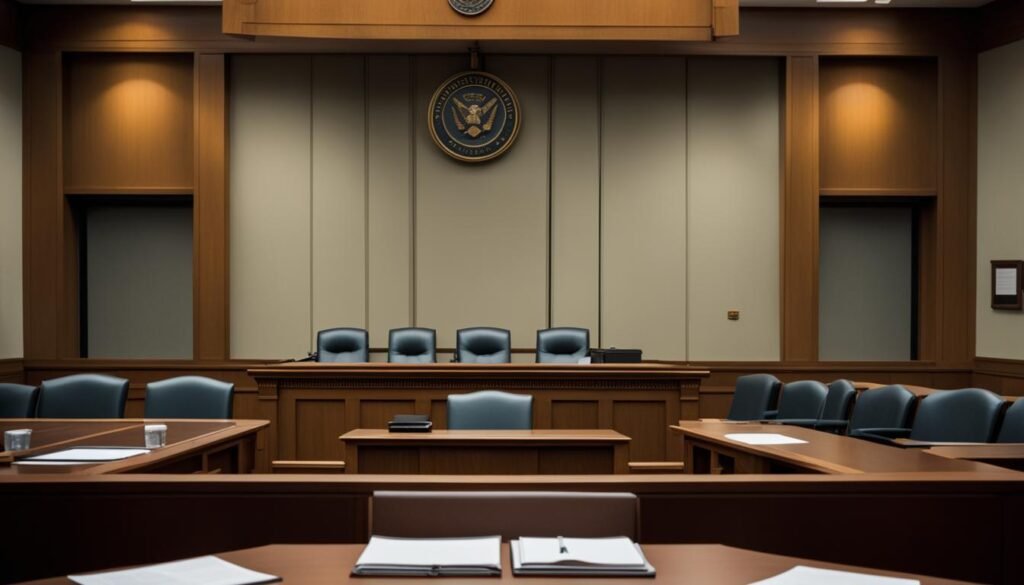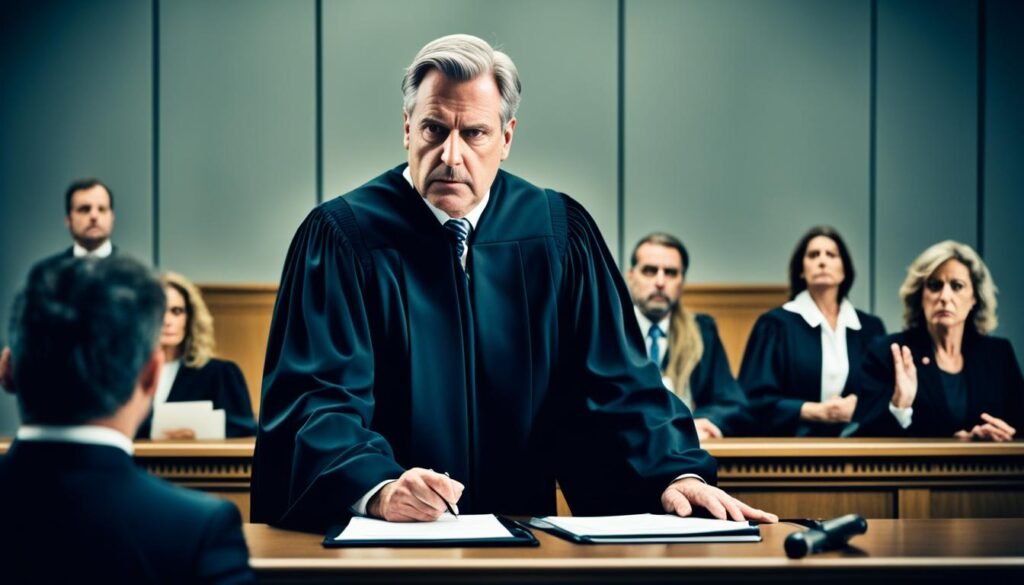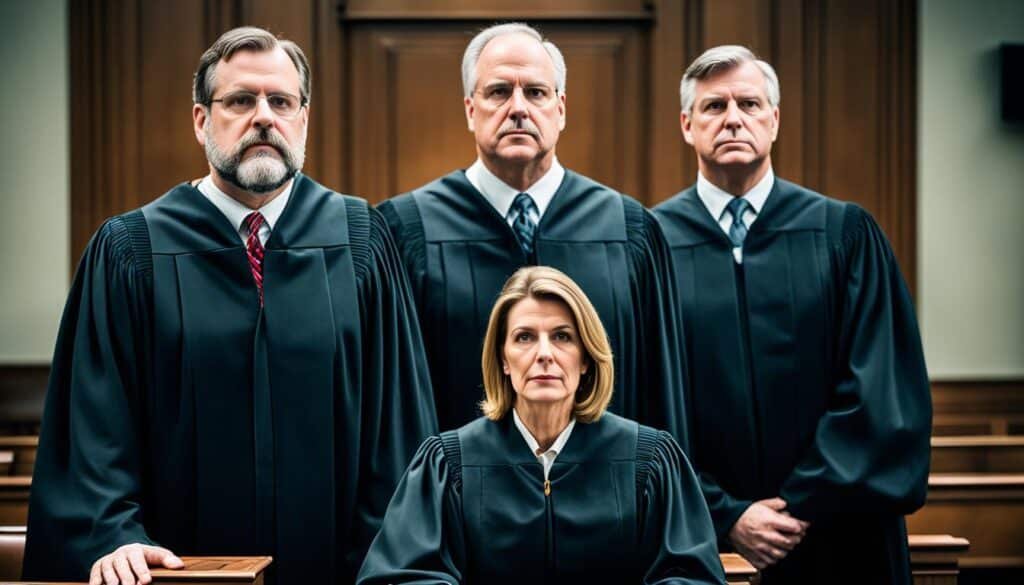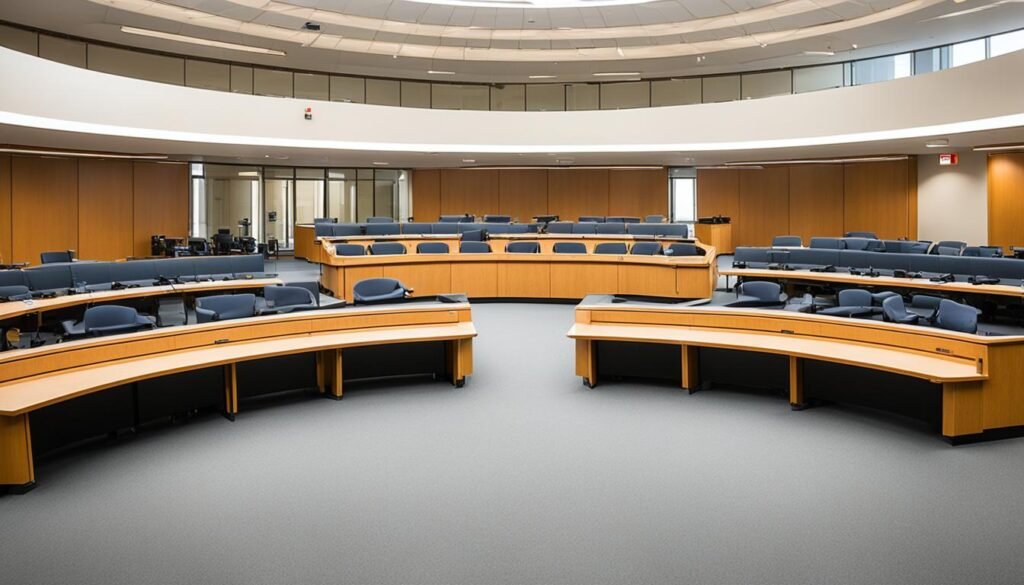The courtroom is at the heart of the American legal system. It handles cases like those against Donald Trump and high-profile lawsuits. Here, justice is pursued every day. This article explores the courtroom’s environment, who’s involved, and how cases are managed, whether criminal or civil.
Courtrooms are built for the legal process. They have space for judges, court staff, lawyers, those on trial, and others. The rooms look serious and important, with high judge’s benches and grand architecture. This design sets the scene for justice to be done.
Readers will get to know everyone in the courtroom. This includes the judge keeping things fair and the jury deciding guilt or innocence. You will learn all about criminal and civil cases, from the start to any appeals. The aim is to show how complex and detailed the system is.
This article also looks at how to behave in court and how technology is used. It ensures everyone can take part, no matter their abilities. By the end, you’ll understand the courtroom’s vital role in making sure justice is served for all.
Key Takeaways
- The courtroom is the central hub of the judicial system, where legal proceedings unfold and the pursuit of justice is carried out.
- Courtrooms are meticulously designed to accommodate the various participants, including judges, court staff, attorneys, defendants/plaintiffs, witnesses, and jurors.
- The article explores the roles and responsibilities of each courtroom participant, as well as the detailed processes for both criminal and civil cases.
- Courtroom etiquette, the integration of technology, and measures to ensure access and fairness are also discussed, providing a comprehensive understanding of the judicial process.
- By delving into the inner workings of the courtroom, readers will gain a deeper appreciation for the complexities and intricacies of the American judicial system.
Understanding the Courtroom Environment
Courtrooms are carefully designed places. They are made for everyone involved in court cases. This design also shows the importance of the legal process. A typical courtroom is shaped like a rectangle or a square. The judge’s bench is at the front. There’s a special area for trials, called the litigation area, separated from where the audience sits by a barrier.
Courtroom Dimensions and Layout
Courtrooms come in different sizes. Some big courthouses have many courtrooms. Each is designed to handle different types of cases. This makes sure everything looks orderly and fair. The courtroom features are set up to help the case process smoothly.
The Litigation Area
Right at the middle of the courtroom is the litigation area or “well”. This is where the judge, lawyers, and witnesses stand during a trial. A barrier separates this area from the public gallery. It keeps things formal and helps the case run smoothly.
The Public Gallery
The public gallery is where anyone can watch the court case. This area can fit many people. How many people can watch depends on the courthouse and the case being tried.
Courtroom Ceiling Height
The height of the courtroom ceiling matters. It affects the overall feel and seriousness of the court. A high ceiling gives a grand feeling. A lower ceiling makes things feel more private and focused.
Courtroom Design and Ambiance
The design and feel of the courtroom really matter. They set up the mood for the case. Things like natural light, color choices, and where they put important symbols all help. They make the court feel significant and serious.
Key Participants in the Courtroom

In the courtroom, many people have important jobs. The judge is in charge. They make decisions based on the law and lead the trial.
The Judge
Judges keep everything in order. They make sure everyone follows the rules and laws. Their job is to be fair to everyone and make sure the trial is just. They rule if evidence can be used and explain the law to the jury.
Court Staff
The courtroom team helps things run smoothly. The bailiff keeps the peace. The court reporter records everything said. The clerk handles important paperwork and keeps the schedule.
Attorneys
Attorneys fight for their clients. They’re either on the defense or the offense. They show evidence, question witnesses, and make their case for why they should win.
Defendants and Plaintiffs
In the case, there are defendants and plaintiffs. Defendants are accused of a crime in criminal cases. Plaintiffs start lawsuits in civil cases.
Witnesses
Witnesses tell their side of the story. They can be experts or people who saw what happened. What they say helps the attorneys prove their case or defend against it.
Jurors
A jury is made up of jurors who decide the case. They come from the community. Jurors look at the facts and apply the law fairly to give their decision.
The Criminal Case Process

The arrest starts the process when someone is taken by the police. Then, they go before a judge for an initial appearance. Here, the judge tells the accused the charges, the right to a lawyer, and how they might get out of jail.
Arrest and Initial Appearance
After an arrest, the accused meets a judge within a day or two. During this first court meeting, the judge lays out the charges and legal rights. They also decide if the person should be freed and under what conditions, like paying bail.
Preliminary Hearing and Arraignment
The legal process moves to a preliminary hearing next. This is where the prosecution shows there’s enough evidence for the charges. If the judge agrees, the case goes to an arraignment. Here, the accused gets their formal charges and enters a plea.
Trial Proceedings
If the accused pleads not guilty, they go to trial. Both sides present evidence and arguments to a judge or a jury. The trial decides if the person is guilty or not, applying the law fairly.
Courtroom
The courtroom is where the trial happens, with the judge and lawyers. It’s a place where respect for the law is shown. The process is important for justice to be served properly.
Jury Deliberations and Verdict
If there’s a jury, they decide the case’s outcome in private. They talk over the evidence to reach a decision. Then, their verdict of guilty or not guilty is announced to everyone.
Sentencing
If the accused is found guilty, the judge sets a punishment. This can include being sent to prison, depending on the crime and guidelines.
Appeals
Even after sentencing, the case might not be over. The accused can request an appeal to review if their legal rights were protected.
The Civil Case Process

The civil case process is about legal fights between people or groups, not breaking a law. This happens when someone believes another person or company did something wrong. It could be a breach of contract, personal injury, or property damage claims.
Filing a Civil Lawsuit
It all starts when the person complaining, the plaintiff, tells the court what’s wrong, in a complaint. They also say what they want as a fix, like money or to stop something. Then the accused person, the defendant, gets to say their side.
Discovery and Pre-Trial Procedures
In the discovery phase, both sides share info, documents, and what witnesses will say. This helps make clear what really happened and gets the case ready for court. Before the trial, there are also meetings, chances to argue points, and settlements to avoid a trial.
Civil Trial Proceedings
If the case goes to trial, both sides tell their story in court. They show proof and question each other’s witnesses. A judge or a group of people, the jury, listens.
Verdict and Judgment
After the trial, the judge or jury decides who’s right and what needs to happen next. This could be paying money, doing something different, or stopping some action.
Appeals in Civil Cases
Not happy with the decision? Either side can ask a higher court to look at the case again, this is an appeal. They might find new facts or mistakes that change the first decision.
| Stage | Description |
|---|---|
| Filing a Lawsuit | The plaintiff initiates the civil case by filing a complaint with the court, outlining the reasons for the lawsuit and the desired remedy. |
| Discovery | Both parties gather and exchange relevant information, documents, and witness testimonies to prepare for the trial. |
| Pre-Trial Procedures | This includes motions, hearings, and potential settlement negotiations between the parties. |
| Civil Trial Proceedings | The trial follows a structured format, with each side presenting evidence and arguments before a judge or jury. |
| Verdict and Judgment | The judge or jury renders a civil verdict, determining liability and the appropriate remedy, such as monetary damages or injunctive relief. |
| Appeals | If either party is dissatisfied with the outcome, they may have the right to file an appeal to a higher court. |
Courtroom Etiquette and Conduct

Keeping the right courtroom etiquette and courtroom conduct is key. It helps keep the court’s dignity during trials. Everyone present, like lawyers, defendants, and even people watching, must follow rules. These rules cover how they act and look in court.
Dress Code
What you wear in court must be formal. For men, this often means suits, dress shirts, and ties. Women might choose suits, dresses, or pantsuits. Dressing formally shows respect for the serious work done in the courtroom.
Behavior and Decorum
Good behavior in the courtroom is very important. People should not act in ways that disturb the trial. This means no talking when you shouldn’t, no phones, and no distractions. Being quiet and alert lets everyone involved focus on their tasks.
Prohibited Items
Some items are not allowed in court because they could cause problems or distractions. These items are usually weapons, phones, laptops, tablets, and food or drinks. Before entering, people might have their things checked. This is to make sure everyone follows these important rules.
Interacting with Court Officials
When talking to court staff, like the judge, be respectful and polite. Call the judge “Your Honor” and others by their formal titles. It’s not okay to disturb or stop them from doing their jobs. Doing so breaks important protocol and courtroom rules.
Role of Technology in the Courtroom

Technology has changed the way legal cases happen in courtrooms today. It brings in audio, video, and digital evidence. This new tech makes things work better and lets more people see what’s happening.
Audio and Video Recording
Courtrooms now use high-tech systems to record what happens. These recordings are an official history of the case. They let people watch or listen from anywhere, which makes following trials easier for everyone.
Presentation of Evidence
Technology has made showing evidence more clear. Lawyers can put up documents, photos, and videos on big screens. This digital way makes the evidence stronger. It helps judges and juries make fair decisions.
Remote Proceedings
The COVID-19 pandemic has pushed courts to go more virtual. Tools like Zoom and Microsoft Teams now help run court cases online. This keeps things going without risking people’s health. It also makes it easier for anyone to be part of a trial.
Ensuring Access and Fairness

The legal system works hard to make sure everyone can use courts fairly. This means making sure courtrooms and legal dealings are open to all. It doesn’t matter if someone has trouble moving, thinking, or understanding the language. The court will help out with disability accommodations and provide language interpretation services as needed.
Accommodations for Disabilities
Courtrooms are set up to be accessible, with things like ramps, elevators, and special seats for those who can’t move easily. They also have devices to help people hear or see better, like assistive listening and real-time captioning. This makes sure everyone can join in, no matter their condition, for fair trials and inclusive courts.
Language Interpretation Services
The law understands not everyone speaks the same language. That’s why there are language interpretation services. These services make it possible for everyone to understand and talk during court. Skilled interpreters help by translating what’s being said clearly. This helps to keep judicial transparency in the accessible courtrooms and ensures equal access.
Public Access and Transparency
One key thing for courts is making sure the public can see what’s happening. Everyone is usually allowed to watch trials or hearings. This is how the legal system stays open and honest, showing that fair trials and inclusive courts really matter. This upholds the value of public access and judicial transparency.
Also Read: How Is International Law Enforced?
Courtroom Security Measures
Keeping everyone safe in the courtroom is very important. The judicial system puts many security steps in place. This is to protect everyone and make sure justice is carried out well.
Screening and Entry Procedures
At the entrance, there are often metal detectors and bag checks. These stop dangerous items, like weapons, from getting inside. Before entering the courtroom, everyone must pass through these checks.
Separating Circulation Routes
Courtrooms are made to keep each group away from the other. This stops fights and keeps everything calm. It makes sure the court runs smoothly and safely for everyone.
Ensuring Participant Safety
Inside the courtroom, there are more safety steps. There are court officers and bailiffs to help. Defendants might be kept in safe cells. Plans for emergencies are also in place, making sure everyone stays safe.
FAQs
Q: What can I expect in the courtroom when Donald Trump is being charged?
A: When Donald Trump is being charged, you can expect a high-profile trial with intense media coverage, heightened security measures, and a significant public interest in the proceedings.
Q: How do I get to the courtroom where Donald Trump’s trial is taking place?
A: To get to the courtroom where Donald Trump’s trial is taking place, you should follow the directions provided by the court or use public transportation if available. Make sure to arrive early and be prepared for additional security procedures.
Q: What happens when appearing in court for a case involving falsifying business records?
A: When appearing in court for a case involving falsifying business records, you will likely be required to present evidence, testimony, and provide any relevant documentation to support your case. The judge may also question you and other witnesses to determine the facts of the case.
Q: Can you explain the role of the foreperson in a courtroom and typically in a case like Trump’s?
A: The foreperson in a courtroom is responsible for leading the jury deliberations, ensuring that discussions are conducted in an orderly manner, and ultimately presenting the jury’s verdict to the court. In a case like Trump’s, the foreperson would play a crucial role in guiding the jury through the evidence and reaching a unanimous decision.
Q: How does the court system handle cases where a former president like Donald Trump is involved?
A: The court system treats cases involving former presidents like Donald Trump with the same legal procedures and standards applied to any other individual. The proceedings are conducted in accordance with the law, ensuring that all parties receive a fair trial and that justice is served.
Q: Who is Manhattan District Attorney Alvin Bragg and what is his involvement in cases related to Trump?
A: Manhattan District Attorney Alvin Bragg is the chief prosecutor for Manhattan County in New York and is responsible for bringing criminal cases to trial. His involvement in cases related to Trump would include overseeing the prosecution, presenting evidence, and arguing the case in court.
Q: What are some of the expectations when dealing with business records in the first degree in a courtroom setting?
A: When dealing with business records in the first degree in a courtroom setting, you can expect detailed scrutiny of the records, expert testimony to explain complex financial matters, and a thorough examination of how the records may have been falsified or manipulated.
Source Links
- https://www.azcourts.gov/guidetoazcourts/How-a-Case-Moves-Through-the-Court-System
- https://www.ncsc.org/courthouseplanning/the-courthouse/trial
- https://judiciallearningcenter.org/your-day-in-court/





